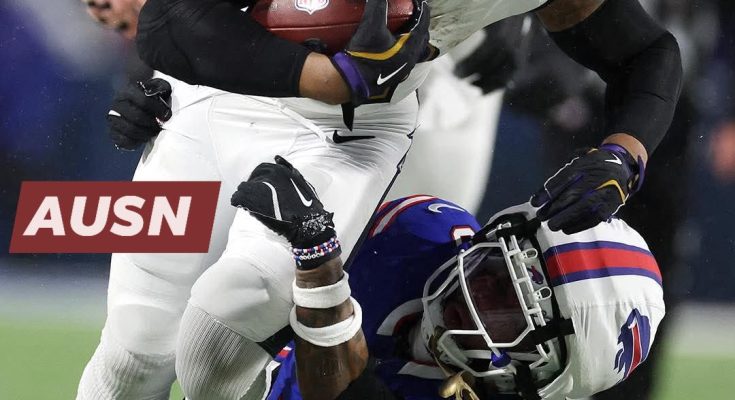Derrick Henry is 31 years old. For many NFL running backs, that would be a milestone marking the twilight of a career, a time when burst and power begin to fade, and the whispers of retirement grow louder. But for Henry, the King, the so-called “fall-off” hasn’t come yet. Instead, he continues to defy the norms of age and attrition in the NFL with performances like the one he put on in the first half against the Buffalo Bills: 9 carries, 122 yards, and a touchdown. That kind of output isn’t just good—it’s historic, and it’s emblematic of what Henry has become over the course of his career. A force of nature. A statistical anomaly. A modern-day gladiator whose style of play shouldn’t be sustainable in today’s game, yet here he is, running through defenses like he’s still 25.
Watching Henry play football is like watching a myth unfold in real time. His combination of size, speed, vision, and sheer willpower is so unique that even in a league of elite athletes, he still looks like he’s operating on a different plane. Listed at 6’3″ and 247 pounds, Henry is built like a linebacker but moves like a wide receiver. That dichotomy has always been the source of his mystique—how does someone so massive move with such grace, such agility, and such controlled violence? When Henry hits the open field, it’s not just a footrace—it’s a nightmare for defensive backs who want no part of tackling him. His stiff-arm has become a signature move, a viral highlight reel in itself. It’s not just that he throws defenders off of him; it’s the way he does it—with dominance, almost contempt, as if to say, “You shouldn’t have tried.”
Against the Bills, Henry reminded everyone why he’s earned the title “King.” Buffalo’s defense isn’t soft; it’s not easily bullied. And yet, Henry made them look ordinary, even fragile. Nine carries and over 120 yards in just one half? That’s the kind of stat line you expect from a back playing against a bottom-tier run defense for an entire game—not what you’d expect against a likely playoff team in just two quarters. It wasn’t just the numbers that impressed—it was the way he ran. He was decisive, punishing, and fluid, cutting through lanes like they were tailor-made for him, breaking tackles as if physics didn’t apply. On his touchdown run, he reached a gear most backs can only dream of hitting. Not bad for a 31-year-old, right?
That age matters in this conversation because the running back position is notoriously unforgiving. It’s a position built on attrition. Most backs burn hot and fade quickly, their bodies unable to withstand the consistent punishment the job demands. A 27-year-old running back is often seen as “aging.” By 29, many are in decline. By 31, most are either role players or out of the league altogether. But Henry has never been “most backs.” Since entering the league in 2016, he has defied that timeline. He’s carried the ball over 2,000 times in his career—more than any active player—and he’s done it with a style that should have worn him down years ago. Instead, he keeps getting up, keeps stiff-arming linebackers into memes, keeps reminding the world that he isn’t done yet.
It’s not like he hasn’t had his setbacks. In 2021, Henry suffered a Jones fracture in his foot, which sidelined him for much of the season. Injuries like that can be career-altering, especially for running backs who rely on explosive cuts and lower-body power. But Henry came back. He worked through the rehab, returned stronger, and resumed dominating. That resilience speaks to more than just his physical gifts—it speaks to his work ethic, his mentality, and his sheer refusal to be counted out. In an age when athletes are increasingly focused on longevity and body maintenance, Henry is the embodiment of old-school toughness meshed with modern performance science.
And let’s not overlook the mental side of Henry’s game. By now, he’s not just running on muscle—he’s running on experience. He sees the field differently than he did at 23. He knows when to press a hole, when to bounce it outside, when to lower his shoulder versus when to turn on the jets. That kind of football IQ, married to his elite athleticism, creates the kind of player who doesn’t just age gracefully—he evolves. If his speed ever dips, his power will still be elite. If his carries ever get limited, his efficiency might improve. He has the tools and the mindset to adapt his game as needed, and that’s what makes him truly dangerous, even at this stage of his career.
The performance against Buffalo also comes in a season where many assumed he might be on the decline. He changed teams. He’s no longer the unquestioned centerpiece of the offense in the way he once was with the Titans. There were legitimate questions heading into this season: Would he still be the same guy? Could he adjust to a new system? Could he handle a different role? But Derrick Henry doesn’t do roles—he sets standards. And if that first half against the Bills is any indication, he’s not slowing down—he’s reintroducing himself.
There’s also a cultural significance to what Henry is doing. He represents a style of play that feels increasingly rare in today’s NFL, where passing dominates and running backs are often devalued. He’s a throwback to the days when the ground game was king, when bruising backs controlled the pace of play and imposed their will on defenses. In an era obsessed with analytics, Henry defies the spreadsheet. He’s not the product of a system—he is the system. And that’s what makes him so beloved by fans and so feared by opponents. You can’t plug and play another back and get Derrick Henry’s impact. You can’t teach what he does. You can only hope to survive it.
And while he’s already cemented his legacy in many ways, Henry’s still adding to it. He’s climbing up the all-time rushing list. He’s entering conversations about Hall of Fame candidacy. Every big game he has now is not just another Sunday—it’s a chapter in a legacy. Performances like the one against Buffalo don’t just boost his team—they bolster his case as one of the greatest backs of his generation, maybe of all time. Longevity, production, impact—he checks every box. And yet, he’s still running like he has something to prove.
That chip on his shoulder, that underdog mentality despite being one of the most dominant backs in league history, is part of what drives him. From high school dominance at Yulee to a Heisman Trophy at Alabama to an NFL career filled with milestones, Henry has always had to prove that he was more than just hype. And now, at 31, he’s proving that greatness doesn’t have an expiration date. He’s rewriting the rules for what a running back’s career can look like.
No one knows how much longer Henry will be able to keep this up. Father Time is undefeated, as they say, and the wear and tear does eventually catch up with everyone. But for now, Derrick Henry is not just surviving—he’s thriving. He’s making history one carry at a time. And if that first-half explosion against Buffalo is a preview of what’s to come this season, then we’re all in for a treat. Because watching Derrick Henry run is not just watching football—it’s watching a legend in motion, a king refusing to abdicate his throne.



